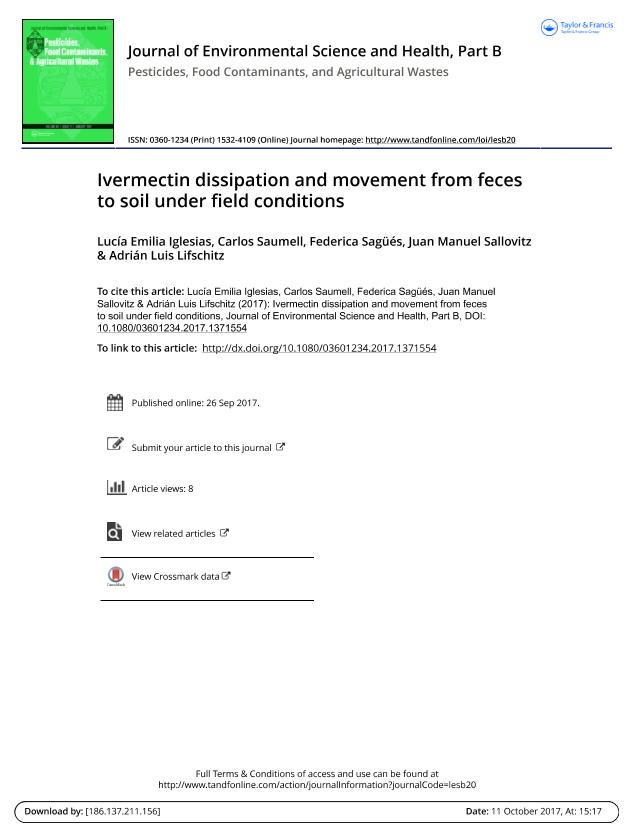Artículo
Ivermectin dissipation and movement from feces to soil under field conditions
Iglesias, Lucía Emilia; Saumell, Carlos Alfredo; Sagüés, María Federica ; Sallovitz, Juan Manuel; Lifschitz, Adrian Luis
; Sallovitz, Juan Manuel; Lifschitz, Adrian Luis
 ; Sallovitz, Juan Manuel; Lifschitz, Adrian Luis
; Sallovitz, Juan Manuel; Lifschitz, Adrian Luis
Fecha de publicación:
09/2017
Editorial:
Taylor
Revista:
Journal of Environmental Science and Health. Part B: Pesticides, Food Contaminants, and Agricultural Wastes
ISSN:
0360-1234
e-ISSN:
1532-4109
Idioma:
Inglés
Tipo de recurso:
Artículo publicado
Clasificación temática:
Resumen
The aim of this work was to evaluate the fate of ivermectin (IVM) at two concentrations in cattle feces and its movement to the nearby soil and plants. Feces were spiked with IVM at two levels: 3000 ng g−1 (high group, HG) and 300 ng g−1 (low group, LG). Artificial dung pats were prepared and deposited in an experimental field area. Feces and underlying soil were sampled up to 60 days post-deposition (dpd). As an additional analysis, grasses growing around the pats were sampled at 30 and 60 dpd. Ivermectin concentrations in all matrices were determined by HPLC. Mean IVM fecal concentrations were in the range between 3901.9 ng g−1 and 2419.2 ng g−1 (high group) and 375.3 ng g−1 and 177.49 ng g−1 (low group). Mean times for 50% and 90% dissipation were 88.23 and 293.03 days (HG) and 39.1 and 129.9 days (LG). Soil concentrations ranged from 26.1 ng g−1 to 71.1 ng g−1 (HG) and 3.4 to 5.9 ng g−1 (LG); in plants, concentrations were between 71.4 and 380.8 ng g−1 and 5.40 and 51.8 ng g−1 in HG and LG, respectively. These results confirm that IVM moves from feces to the underlying soil as well as to nearby plants. The potential risk of detrimental effects on soil organisms and the impact on herbivorous animals should be further evaluated.
Palabras clave:
Cattle
,
Ecotoxicology
,
Endectocides
,
Feces
,
Ivermectin
,
Plants
,
Soil
Archivos asociados
Licencia
Identificadores
Colecciones
Articulos(CIVETAN)
Articulos de CENTRO DE INVESTIGACION VETERINARIA DE TANDIL
Articulos de CENTRO DE INVESTIGACION VETERINARIA DE TANDIL
Citación
Iglesias, Lucía Emilia; Saumell, Carlos Alfredo; Sagüés, María Federica; Sallovitz, Juan Manuel; Lifschitz, Adrian Luis; Ivermectin dissipation and movement from feces to soil under field conditions; Taylor; Journal of Environmental Science and Health. Part B: Pesticides, Food Contaminants, and Agricultural Wastes; 53; 1; 9-2017; 1-7
Compartir
Altmétricas



